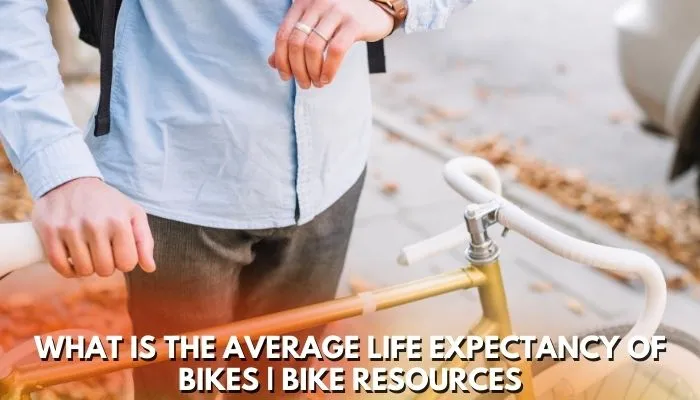What Is The Average Life Expectancy Of Bikes? Bike Resources

Unfortunately, your bike isn’t going to survive forever. Therefore, it’s a smart option to determine the duration that it’s expected to last before you decide to purchase it. Planning ahead is essential because a decent bike is a considerable purchase.
Table of Contents
Short Answer:
So, how long do bikes last? A good bike should last the majority of its customers 30k to 50k miles, or around 5 years of everyday usage if there is no substantial or severe deterioration. Depending on the kind of riding, the amount of energy that is used, etc., the precise lifespan will fluctuate. Furthermore, a bike can live significantly longer when properly serviced, and its parts are updated as required.
Whether you tackle it in the workshop or a store, maintenance of a bike is vital. Knowing whether to update brake pads or the extent to which longer a frame will last depends upon your capacity to create an approximation. Simply having that knowledge is all that the vast majority of riders need. Put the brakes on now, and let’s move on.
How Long Do Bikes Last?
While it’s not tough, you should count on at least 4 to 5 years. While forks and frames may last for a generation, other parts only withstand between six and twelve months of regular use. It relies on the rider as an individual as well as the equipment, circumstances, and upkeep. It should be highlighted that although cutting-edge bikes and parts could become old every few years, they ought to remain functional.
It greatly depends on distance and the weather. By limiting your rides to small distances in clear but not dirty circumstances, you may be in a position to put off major repairs and maintenance for years. The same bike, meanwhile, can require dozens of times a year of significant upkeep and part replacements when it’s being utilized for long daily commutes in dirty, terrible conditions.
What Factors Influence The Longevity Of A Bike?

- The lifespan of the bike will depend on its quality.
The longevity of the bike you buy will be hugely affected by its condition. A bike from Walmart, for instance, is inexpensive but may only sustain you for a handful of years. You could be capable of extending that to five years with great maintenance.
On the other extreme, a high-quality carbon-fiber bike might hypothetically survive for an unending period if it is properly cared for and maintained. Better components and supplies are employed during the manufacture of higher-quality bikes, which will enhance their performance and prolong their expected lifespan.
- The lifespan of a bike will depend on its type.
The kind of bike can additionally have a role in how long do bikes last. For instance, a gently used mountain bike will generally last a good while longer than a severely used touring bike with more fragile equipment. This is because mountain bikes are intended to be robust and withstand some heavy hits.
On the other extreme, children’s bikes are only intended to be used by kids for a short while before they exceed them and transition to bigger bikes.
- The lifespan of the bike will depend on how frequently you use it.
It matters just as much how many miles you’ve done on your bike as its age. A bike that is used 5,000 miles a year is going to suffer much greater wear and tear compared to one that’s used only a couple hundred miles per year.
Furthermore, a bike will be put under significantly greater pressure during a regular commute or activity compared to when enjoying a pleasant, infrequent ride.
- The Longevity of Your Bike May Be Affected by Riding and Storage Circumstances
The riding situation will also influence your bike’s durability. Your bike will wear out more rapidly if you ride it in the rain, muck, and dust than if you just ride it in decent weather and on flat, smooth pavement.
The lifespan of your bike will be substantially enhanced if you keep it indoors, where it is adequately secured from the environment, compared to constantly leaving it out in the frigid rain. To extend the lifespan of your bike, shield it from bad weather.
- The Longevity of Your Bike Will Be Affected by Maintenance
Your bike requires maintenance comparable to what a car does. Also, a bike that has been properly maintained will live much longer than one that has not. For instance, you should frequently clean and lubricate the chain on your bike.
The entire drive train will suffer more wear and tear as a consequence of a dirty bike chain, which will result in your bike, or at minimum, a few of its pricey parts, wearing out more rapidly. Hence, to increase the life of your bike, keep it clean and well-maintained.
- Your bike’s lifespan will be shortened by damage.
Crashing your bike is the easiest way to decrease its average lifespan. In some ways, it’s impossible to anticipate how much your bike will endure since damage might lead to an eventual demise. While other types of harm could progressively deplete the lifespan of your bike, a bike accident can put an abrupt halt to it.
Steel bike frames may be repaired significantly more cheaply than carbon fiber and aluminum bike frames, which are all either impossible to fix or are exceedingly hard and costly to do so.
- The Life of Your Bike Can Be Extended with Upgrades
The longevity of your bike can be increased with several modifications. For instance, a few additional years on your bike can be gained by altering the bike drivetrain when it begins to break down. But, if you believe you have outpaced your bike totally and must upgrade to a brand-new bike, your bike may experience an unfortunate end. For instance, if you’ve been biking for a while, you might wish to upgrade from an entry-level bike to a race bike.
Your bike may endure between five and ten years; however, only if it’s maintained in good condition. The requirement for replacing many bike parts is higher than that of the bike overall, including things like the chain and cassette. However, doing so will increase the bike’s lifespan, and as long as the structure is robust and in great condition, you must be capable of keeping it on if the parts are properly maintained.
Which Bikes Have The Longest Lifespans?

Talking about how long do bikes last, no bike design outperforms the others by a significant margin. Nonetheless, steel-frame city bikes continue to be utilized after a couple of decades and are rather common.
Most are built of sturdy, thick-walled pipes that can endure knocks and fractures and, with regular maintenance, can last for an unimaginable amount of time.
Remember that the greatest life is not the same as the period of time that can run with no maintenance. On the other side, a decent belt-drive bike can function for years without drivetrain upkeep, although an unbreakable classic city bike needs chain maintenance.
Why Inexpensive Bikes Are Less Durable
Inexpensive bikes, such as those from retail stores and big-box retailers, frequently experience issues during their initial few rides. If something does occur, poor assembly is generally to blame rather than a flaw in the bike itself.
However, the interior parts of many ultra-cheap bikes, such as the headset or hub bearings, often are substandard. They might experience problems within a few weeks that finer bikes haven’t encountered for several years.
Fortunately, there isn’t a very high standard for “better bikes.” We’re talking about spending about 500 dollars, give or take, to buy a budget-friendly bike from a well-known brand from a bike store. As long as the chain is greased, the tires are pumped, and the cable tension is regulated, such bikes ought to serve the average commuter or leisure biker for 6 to 12 months.
How Frequently Should My Bike Be Replaced?
Unless the frame or forks are heavily damaged, you shouldn’t need to purchase a new bike. Despite so, steel and carbon bikes could still be easy to repair if they don’t have any cracks, rust, or deterioration. If it no longer meets your requirements or preferences, however, and altering it would be challenging or costly, then it is worth replacing.
Many riders favor tried-and-true parts that haven’t changed all that much over the past couple of decades. This excludes features with an emphasis on high performance and competition, but it also eliminates specifications that are continually shifting and becoming outdated.
On the other extreme, other people simply like to have the most recent and superior parts, so they update every few years. That’s simply how often the majority of bike types experience significant adjustments; it doesn’t indicate you should.
Do Bikes Come With A Lifetime Warranty?
Lifetime guarantees from several well-known manufacturers guarantee only stiff forks and frames. There is almost never a lifelong warranty on suspension forks or most other components. Keep in mind that warranties may differ by region and are null and void if the bike is altered or utilized for reasons other than those for which it was originally manufactured.
Manufacturer warranties provide a little insight into the expected lifetime of a frame. However, they are not precise science. The fact that a brand’s warranty is longer does not necessarily indicate that it is more reliable or that it’s going to endure over the course of your lifetime.
It might originate from an accounting team who believes you’ll sell it before issues arise or from a lesser risk-averse legal team! Concerning bikes or pretty much any other item, keep in mind that lifetime guarantees only pertain to the actual owner.
FAQs:
Can brand-new bikes travel far?
Before having your bike’s first service performed, we recommend taking a lengthy ride. On the highway, riding the bike faster than 60 kilometers per hour is not suggested because the average speed continues to climb. Also, the engine tends to heat up, which is not ideal for your engine’s lifespan.
Do bikes get damaged in the rain?
Rain will not instantly damage a bike. A bike’s chain, cassette, and derailleur can suffer significant harm from corrosion or rust if exposed to the outdoors for an extended period of time. The best part is that you can weatherproof every part of your bike in a number of different ways.
If we don’t ride our bikes for six months, what happens?
The amount of time the bike was left unused and the weather that had an effect during that time influenced how fast the bike corroded. When it relates to a bike, rusting is a major problem, especially with the gas tank, engine, and other parts. Rusting can occur on the interior as well as on the exterior, so it’s not only a surface issue.
How much time on a bike is considered safe?
Everyone who has no desire to run might take advantage of biking as a good cardio exercise. It is excellent for both more moderate workouts and hard workouts because it is both high-intensity and low-impact at the same time.
Biking for 15 to 20 minutes every day may be beneficial to your cardiovascular system, in accordance with a variety of investigations.
Conclusion:
Now you know how long do bikes last? Five years from the date of purchase, or 50,000 miles, is typically considered the average bike lifespan for riders who ride regularly. That being said, a bike’s typical lifespan depends heavily on its upkeep and which components you truly regard to be a part of the bike.
Your bike might last considerably longer if you keep changing the parts (basically a lifetime).
But, there may come a time when buying an entirely novel bike is more cost-effective than replacing individual components. Make a decision and resume riding after carefully considering your options and determining how much upkeep you can or must do.
